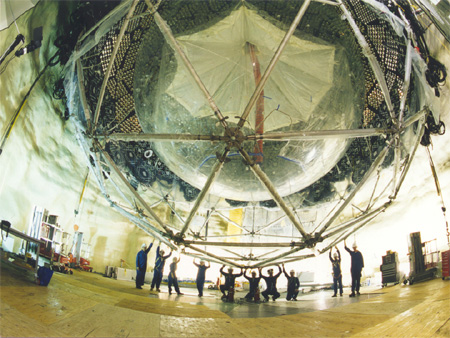
Deep underground, in the Canadian Shield of Northeastern Ontario, a new world-class neutrino detector is poised to begin its measurements. Featuring a core of one million litres of Canada's heavy water in a unique acrylic sphere, 12 meters in diameter, the Sudbury Neutrino Observatory will use its unique sensitivity to all three flavours of neutrinos to investigate neutrinos from the Sun. At its great depth, and as a result of careful selection of materials for the detector and cleanliness during construction, the Observatory will have an excellent environment for its neutrino measurements.
When the filling of ultra pure regular water in the outer part of the SNO cavity and the heavy water in the acrylic vessel is complete, SNO will see neutrinos through 3 separate reactions, two of them never before observed. A neutrino is detected as a tiny burst of blue-violet light, captured by SNO's 9500 light sensors mounted in a geodesic sphere which surrounds the heavy water. Although trillions of neutrinos from the sun pass through the rock above and the SNO detector each second, only about 20 of them will be seen each day.
| . |  |
| Above: A photo of the SNO detector showing the completed acrylic plastic sphere (12 m in diameter) surrounded by a stainless steel geodesic sphere containing many of SNO's 9600 light sensors. The detector wascompleted by finishing the light sensor panel installation in the geodesic, removing the bottom platform in the SNO cavity, sealing a lower exit from the cavity via a bulkhead, and filling with water. (Bob Chambers, SNO) |
The successful completion of the SNO detector is a tribute to: the teamwork of an ever-growing group of scientists who planned and designed the experiment; the cooperative support by the group of funding agencies from Canada, the United States and Great Britain; the interest and cooperation of Inco Limited in providing the site and the support for the laboratory and its construction; the willingness of Canada's federal agency, Atomic Energy of Canada Limited, to loan the heavy water (valued at $300 million) for the experiment; the Inco geotechnical team which designed the cavity and the lnco miners who excavated it; the team of engineers, led by SNO's project managers Agra-Monenco/Canatom, working with companies and workers from Northern Ontario and from around the world; the teams from many SNO research partner institutions who designed and helped install many of the detector's components and systems, including electronics, water purification systems, lab systems control, software program development, acrylic vessel installation support, the unique geodesic and panel system for SNO's light sensors, cleanliness, and radioactive monitoring; the excellent work of a large group of SNO employees whose dedication, adaptability and cooperation were vitally important.
SNO's Unique Technology
In assembling this unique detector, SNO has stretched existing technology and pioneered new material and instrumentation development. Among the requirements and developments are:
A huge underground cavern 22 meters across and 34 meters high - the largest, at its 2000 in depth, in the world. This achievement was made possible by new excavation and ground support technology developed by Inco Limited.
A water and radon proof cavern liner for the huge water volume needed for the detector. SNO has pioneered new application and quality control methods, including the development of an x-ray backscatter thickness monitor to successfully complete this liner.
Ultrapure materials for the light sensors, inner acrylic vessel and support ropes. With its partner companies, SNO has acquired special materials with extra quality control, often resulting in components which are one-of-a-kind in the world. Monitoring techniques for these ultrapure materials have also been extended or pioneered by SNO scientists.
A requirement for a unique support structure for the 9500 light sensors for the detector, led to the development of a stainless-steel geodesic sphere and panel mount system by SNO collaborators at Lawrence Berkeley Laboratory (USA).
SNO needed the world's largest acrylic plastic vessel, 12 m in diameter, to hold 1000 tonnes of Canada's heavy water, as the neutrino sensor for the detector. This structure was prepared from 120 curved panels and assembled underground through a unique process involving the vessel designer and fabricator - Reynold's Polymer Technology - a world leader in acrylic technology, as well as SNO personnel.
SNO also required the world's purest water, for the detector's core. The design and installation of a water filtration and monitoring system by a group led by SNO personnel from the Centre for Research in Particles Physics and industrial partners, stretches purification technology to new limits.
To prevent interferences with neutrino measurements, the SNO laboratory needed to be one of the largest cleanroom labs in the world, deep in the heart of a busy nickel mine. SNO has achieved the required ultraclean conditions throughout the assembly process, using technical developments by Laurentian University and Lawrence Berkeley National Laboratory.
Specially designed electronics chips, circuits and components for processing signals from neutrino events so that location, energy and reaction type can be determined with excellent accuracy. New microchip designs and components have been produced under the direction of SNO groups at University of Pennsylvania and Queen's University, and specialized computer software has been developed by groups at the University of Washington and other SNO institutions.
Reprinted courtesy of the Sudbury Neutrino Observatory